Principles of Accounting - Company Law: Registration and Liability
VerifiedAdded on 2021/06/18
|10
|2559
|33
Homework Assignment
AI Summary
This assignment delves into two key issues within the realm of accounting and company law. The first question addresses the process of registering a company, outlining the necessary steps according to the Corporations Act 2001, including application requirements, ASIC responsibilities, and the implications of incorporation. The second question examines corporate liability, specifically focusing on whether an employee, Terry, can initiate legal proceedings against a company (CMS), its parent company (CM), or a new acquiring company (Lazarus Pty Ltd) following environmental contamination and resulting health issues. The analysis explores the concept of separate legal entities, the corporate veil, and the limitations on piercing it, ultimately concluding that Terry's legal options are limited due to the structure of the companies and the legal principles governing their actions and liabilities. The assignment draws on relevant case law and statutory provisions to support its conclusions.
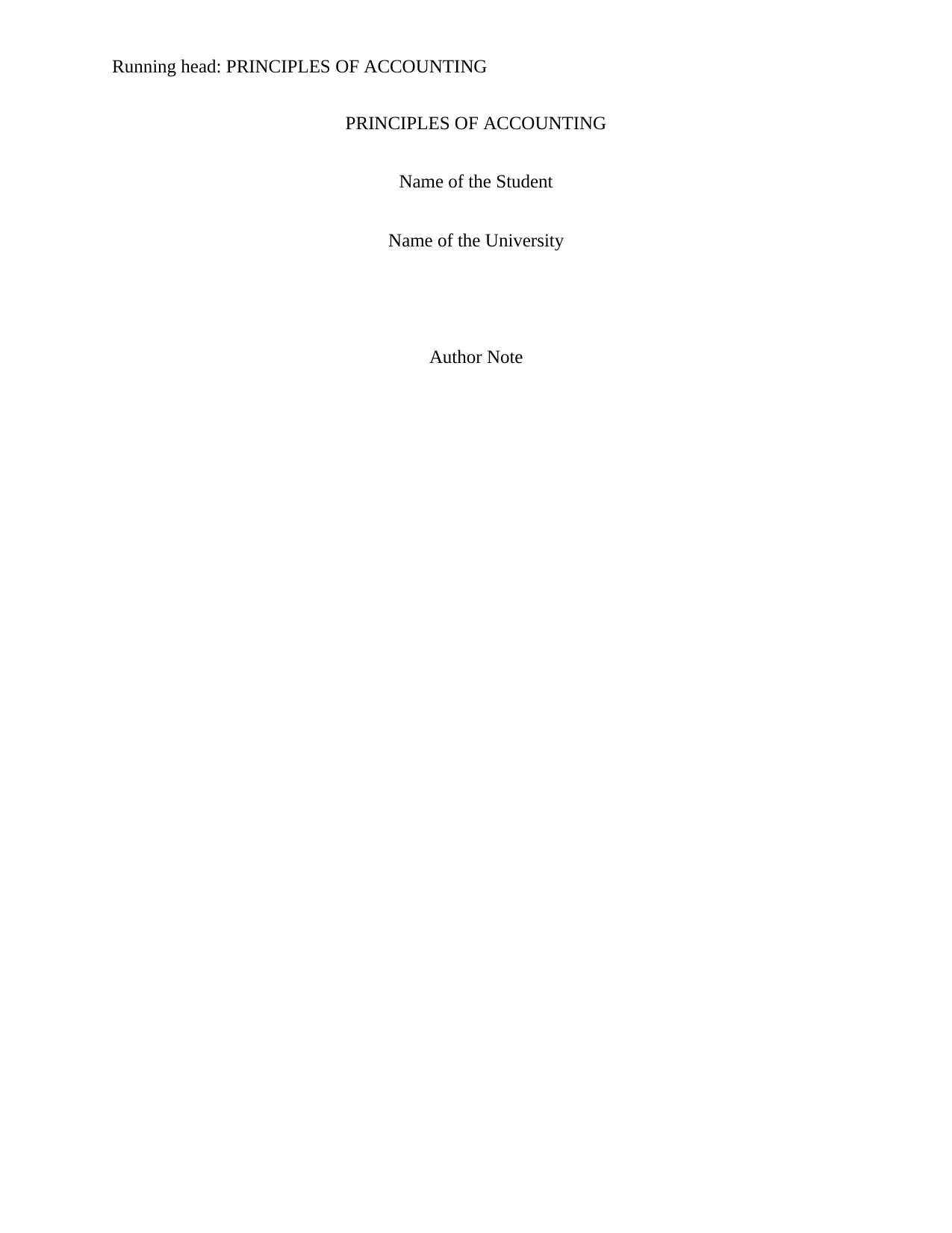
Running head: PRINCIPLES OF ACCOUNTING
PRINCIPLES OF ACCOUNTING
Name of the Student
Name of the University
Author Note
PRINCIPLES OF ACCOUNTING
Name of the Student
Name of the University
Author Note
Paraphrase This Document
Need a fresh take? Get an instant paraphrase of this document with our AI Paraphraser
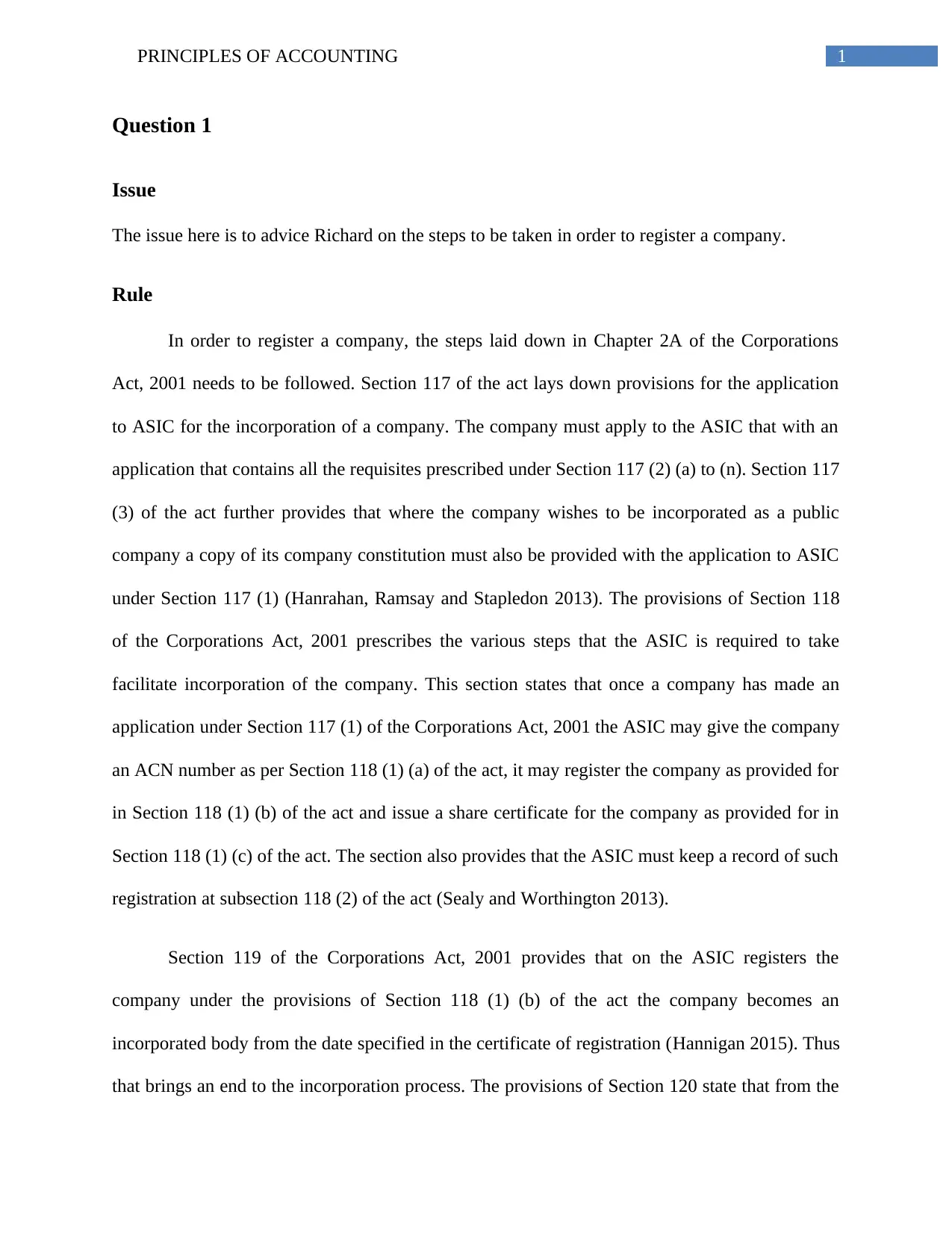
1PRINCIPLES OF ACCOUNTING
Question 1
Issue
The issue here is to advice Richard on the steps to be taken in order to register a company.
Rule
In order to register a company, the steps laid down in Chapter 2A of the Corporations
Act, 2001 needs to be followed. Section 117 of the act lays down provisions for the application
to ASIC for the incorporation of a company. The company must apply to the ASIC that with an
application that contains all the requisites prescribed under Section 117 (2) (a) to (n). Section 117
(3) of the act further provides that where the company wishes to be incorporated as a public
company a copy of its company constitution must also be provided with the application to ASIC
under Section 117 (1) (Hanrahan, Ramsay and Stapledon 2013). The provisions of Section 118
of the Corporations Act, 2001 prescribes the various steps that the ASIC is required to take
facilitate incorporation of the company. This section states that once a company has made an
application under Section 117 (1) of the Corporations Act, 2001 the ASIC may give the company
an ACN number as per Section 118 (1) (a) of the act, it may register the company as provided for
in Section 118 (1) (b) of the act and issue a share certificate for the company as provided for in
Section 118 (1) (c) of the act. The section also provides that the ASIC must keep a record of such
registration at subsection 118 (2) of the act (Sealy and Worthington 2013).
Section 119 of the Corporations Act, 2001 provides that on the ASIC registers the
company under the provisions of Section 118 (1) (b) of the act the company becomes an
incorporated body from the date specified in the certificate of registration (Hannigan 2015). Thus
that brings an end to the incorporation process. The provisions of Section 120 state that from the
Question 1
Issue
The issue here is to advice Richard on the steps to be taken in order to register a company.
Rule
In order to register a company, the steps laid down in Chapter 2A of the Corporations
Act, 2001 needs to be followed. Section 117 of the act lays down provisions for the application
to ASIC for the incorporation of a company. The company must apply to the ASIC that with an
application that contains all the requisites prescribed under Section 117 (2) (a) to (n). Section 117
(3) of the act further provides that where the company wishes to be incorporated as a public
company a copy of its company constitution must also be provided with the application to ASIC
under Section 117 (1) (Hanrahan, Ramsay and Stapledon 2013). The provisions of Section 118
of the Corporations Act, 2001 prescribes the various steps that the ASIC is required to take
facilitate incorporation of the company. This section states that once a company has made an
application under Section 117 (1) of the Corporations Act, 2001 the ASIC may give the company
an ACN number as per Section 118 (1) (a) of the act, it may register the company as provided for
in Section 118 (1) (b) of the act and issue a share certificate for the company as provided for in
Section 118 (1) (c) of the act. The section also provides that the ASIC must keep a record of such
registration at subsection 118 (2) of the act (Sealy and Worthington 2013).
Section 119 of the Corporations Act, 2001 provides that on the ASIC registers the
company under the provisions of Section 118 (1) (b) of the act the company becomes an
incorporated body from the date specified in the certificate of registration (Hannigan 2015). Thus
that brings an end to the incorporation process. The provisions of Section 120 state that from the
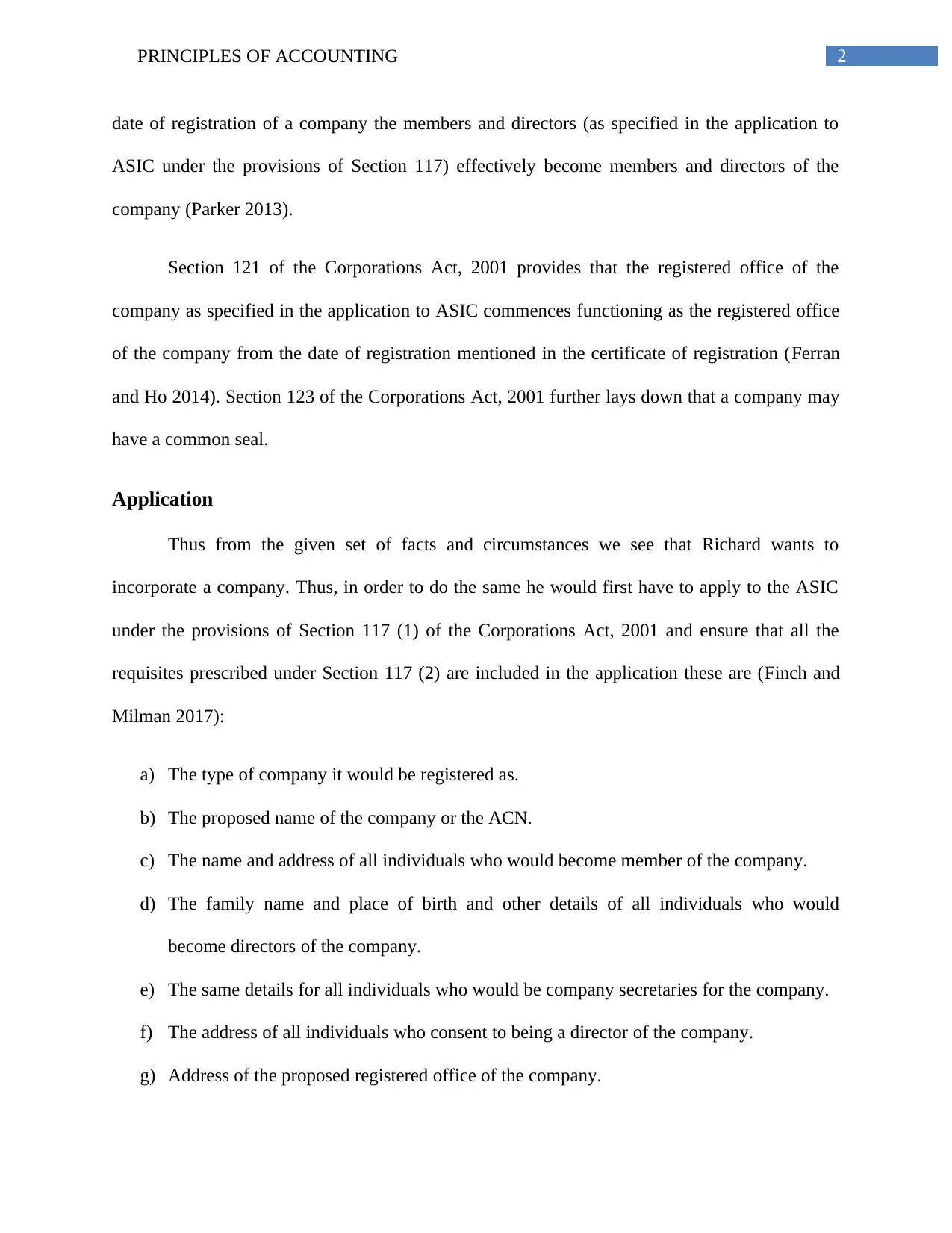
2PRINCIPLES OF ACCOUNTING
date of registration of a company the members and directors (as specified in the application to
ASIC under the provisions of Section 117) effectively become members and directors of the
company (Parker 2013).
Section 121 of the Corporations Act, 2001 provides that the registered office of the
company as specified in the application to ASIC commences functioning as the registered office
of the company from the date of registration mentioned in the certificate of registration (Ferran
and Ho 2014). Section 123 of the Corporations Act, 2001 further lays down that a company may
have a common seal.
Application
Thus from the given set of facts and circumstances we see that Richard wants to
incorporate a company. Thus, in order to do the same he would first have to apply to the ASIC
under the provisions of Section 117 (1) of the Corporations Act, 2001 and ensure that all the
requisites prescribed under Section 117 (2) are included in the application these are (Finch and
Milman 2017):
a) The type of company it would be registered as.
b) The proposed name of the company or the ACN.
c) The name and address of all individuals who would become member of the company.
d) The family name and place of birth and other details of all individuals who would
become directors of the company.
e) The same details for all individuals who would be company secretaries for the company.
f) The address of all individuals who consent to being a director of the company.
g) Address of the proposed registered office of the company.
date of registration of a company the members and directors (as specified in the application to
ASIC under the provisions of Section 117) effectively become members and directors of the
company (Parker 2013).
Section 121 of the Corporations Act, 2001 provides that the registered office of the
company as specified in the application to ASIC commences functioning as the registered office
of the company from the date of registration mentioned in the certificate of registration (Ferran
and Ho 2014). Section 123 of the Corporations Act, 2001 further lays down that a company may
have a common seal.
Application
Thus from the given set of facts and circumstances we see that Richard wants to
incorporate a company. Thus, in order to do the same he would first have to apply to the ASIC
under the provisions of Section 117 (1) of the Corporations Act, 2001 and ensure that all the
requisites prescribed under Section 117 (2) are included in the application these are (Finch and
Milman 2017):
a) The type of company it would be registered as.
b) The proposed name of the company or the ACN.
c) The name and address of all individuals who would become member of the company.
d) The family name and place of birth and other details of all individuals who would
become directors of the company.
e) The same details for all individuals who would be company secretaries for the company.
f) The address of all individuals who consent to being a director of the company.
g) Address of the proposed registered office of the company.
⊘ This is a preview!⊘
Do you want full access?
Subscribe today to unlock all pages.

Trusted by 1+ million students worldwide
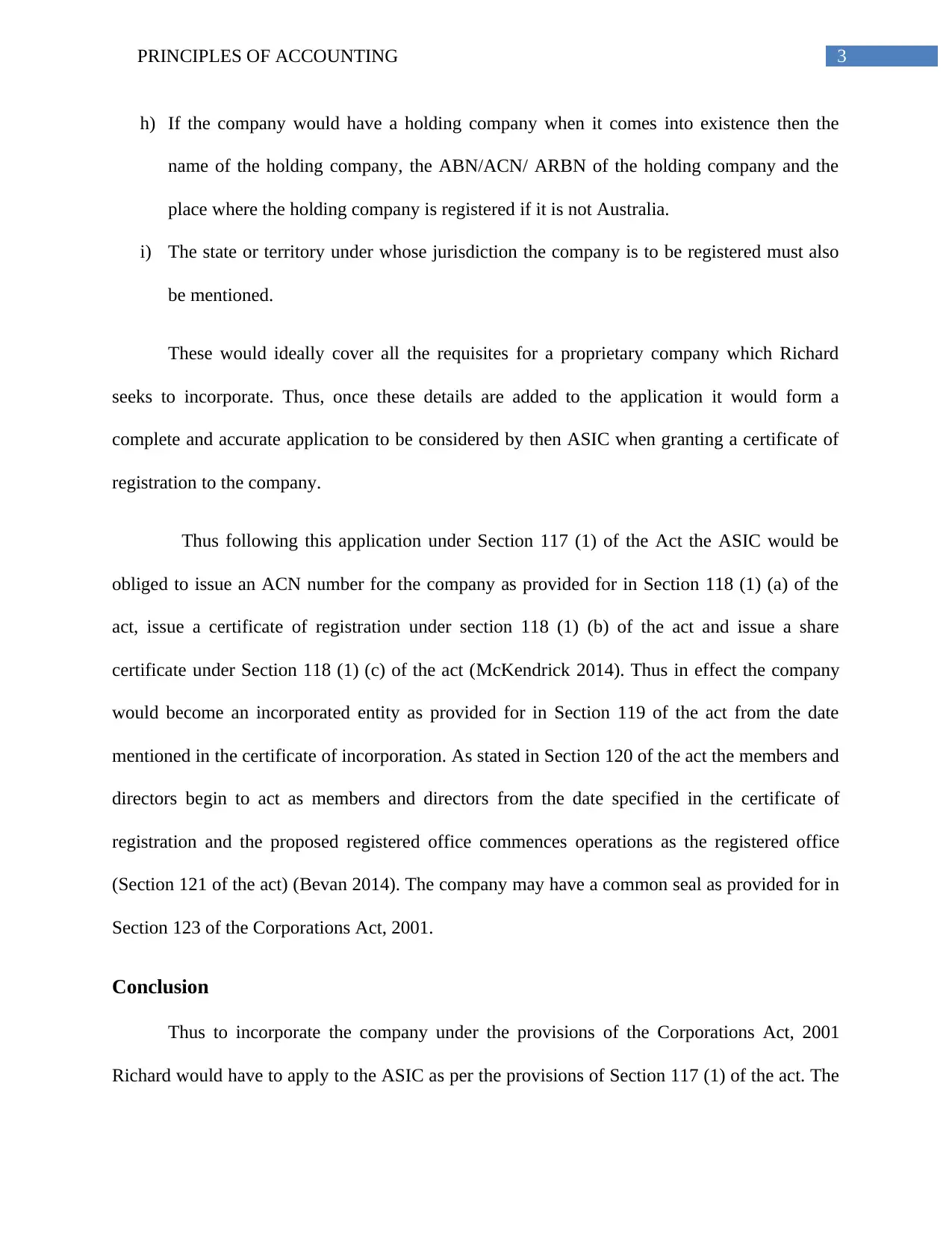
3PRINCIPLES OF ACCOUNTING
h) If the company would have a holding company when it comes into existence then the
name of the holding company, the ABN/ACN/ ARBN of the holding company and the
place where the holding company is registered if it is not Australia.
i) The state or territory under whose jurisdiction the company is to be registered must also
be mentioned.
These would ideally cover all the requisites for a proprietary company which Richard
seeks to incorporate. Thus, once these details are added to the application it would form a
complete and accurate application to be considered by then ASIC when granting a certificate of
registration to the company.
Thus following this application under Section 117 (1) of the Act the ASIC would be
obliged to issue an ACN number for the company as provided for in Section 118 (1) (a) of the
act, issue a certificate of registration under section 118 (1) (b) of the act and issue a share
certificate under Section 118 (1) (c) of the act (McKendrick 2014). Thus in effect the company
would become an incorporated entity as provided for in Section 119 of the act from the date
mentioned in the certificate of incorporation. As stated in Section 120 of the act the members and
directors begin to act as members and directors from the date specified in the certificate of
registration and the proposed registered office commences operations as the registered office
(Section 121 of the act) (Bevan 2014). The company may have a common seal as provided for in
Section 123 of the Corporations Act, 2001.
Conclusion
Thus to incorporate the company under the provisions of the Corporations Act, 2001
Richard would have to apply to the ASIC as per the provisions of Section 117 (1) of the act. The
h) If the company would have a holding company when it comes into existence then the
name of the holding company, the ABN/ACN/ ARBN of the holding company and the
place where the holding company is registered if it is not Australia.
i) The state or territory under whose jurisdiction the company is to be registered must also
be mentioned.
These would ideally cover all the requisites for a proprietary company which Richard
seeks to incorporate. Thus, once these details are added to the application it would form a
complete and accurate application to be considered by then ASIC when granting a certificate of
registration to the company.
Thus following this application under Section 117 (1) of the Act the ASIC would be
obliged to issue an ACN number for the company as provided for in Section 118 (1) (a) of the
act, issue a certificate of registration under section 118 (1) (b) of the act and issue a share
certificate under Section 118 (1) (c) of the act (McKendrick 2014). Thus in effect the company
would become an incorporated entity as provided for in Section 119 of the act from the date
mentioned in the certificate of incorporation. As stated in Section 120 of the act the members and
directors begin to act as members and directors from the date specified in the certificate of
registration and the proposed registered office commences operations as the registered office
(Section 121 of the act) (Bevan 2014). The company may have a common seal as provided for in
Section 123 of the Corporations Act, 2001.
Conclusion
Thus to incorporate the company under the provisions of the Corporations Act, 2001
Richard would have to apply to the ASIC as per the provisions of Section 117 (1) of the act. The
Paraphrase This Document
Need a fresh take? Get an instant paraphrase of this document with our AI Paraphraser
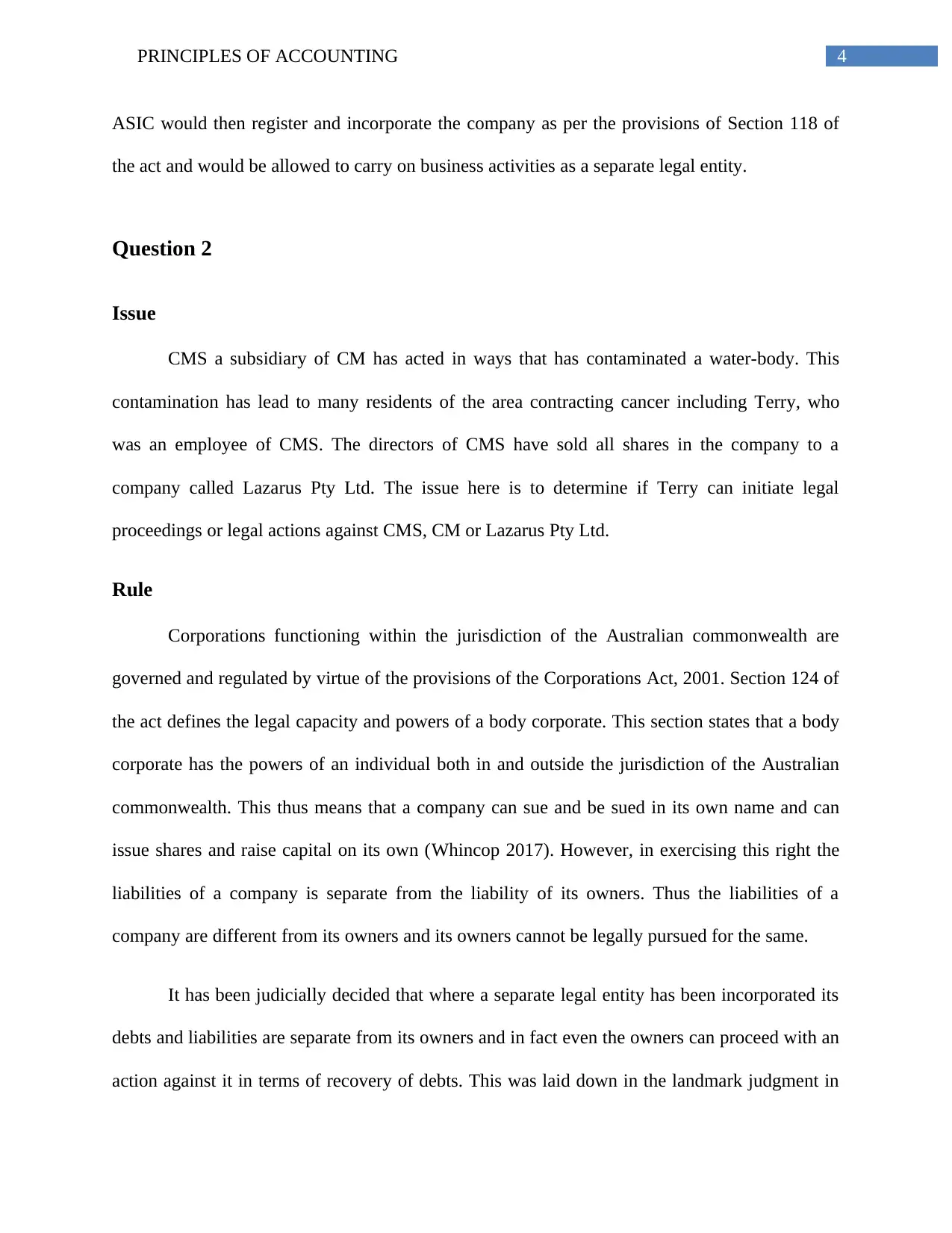
4PRINCIPLES OF ACCOUNTING
ASIC would then register and incorporate the company as per the provisions of Section 118 of
the act and would be allowed to carry on business activities as a separate legal entity.
Question 2
Issue
CMS a subsidiary of CM has acted in ways that has contaminated a water-body. This
contamination has lead to many residents of the area contracting cancer including Terry, who
was an employee of CMS. The directors of CMS have sold all shares in the company to a
company called Lazarus Pty Ltd. The issue here is to determine if Terry can initiate legal
proceedings or legal actions against CMS, CM or Lazarus Pty Ltd.
Rule
Corporations functioning within the jurisdiction of the Australian commonwealth are
governed and regulated by virtue of the provisions of the Corporations Act, 2001. Section 124 of
the act defines the legal capacity and powers of a body corporate. This section states that a body
corporate has the powers of an individual both in and outside the jurisdiction of the Australian
commonwealth. This thus means that a company can sue and be sued in its own name and can
issue shares and raise capital on its own (Whincop 2017). However, in exercising this right the
liabilities of a company is separate from the liability of its owners. Thus the liabilities of a
company are different from its owners and its owners cannot be legally pursued for the same.
It has been judicially decided that where a separate legal entity has been incorporated its
debts and liabilities are separate from its owners and in fact even the owners can proceed with an
action against it in terms of recovery of debts. This was laid down in the landmark judgment in
ASIC would then register and incorporate the company as per the provisions of Section 118 of
the act and would be allowed to carry on business activities as a separate legal entity.
Question 2
Issue
CMS a subsidiary of CM has acted in ways that has contaminated a water-body. This
contamination has lead to many residents of the area contracting cancer including Terry, who
was an employee of CMS. The directors of CMS have sold all shares in the company to a
company called Lazarus Pty Ltd. The issue here is to determine if Terry can initiate legal
proceedings or legal actions against CMS, CM or Lazarus Pty Ltd.
Rule
Corporations functioning within the jurisdiction of the Australian commonwealth are
governed and regulated by virtue of the provisions of the Corporations Act, 2001. Section 124 of
the act defines the legal capacity and powers of a body corporate. This section states that a body
corporate has the powers of an individual both in and outside the jurisdiction of the Australian
commonwealth. This thus means that a company can sue and be sued in its own name and can
issue shares and raise capital on its own (Whincop 2017). However, in exercising this right the
liabilities of a company is separate from the liability of its owners. Thus the liabilities of a
company are different from its owners and its owners cannot be legally pursued for the same.
It has been judicially decided that where a separate legal entity has been incorporated its
debts and liabilities are separate from its owners and in fact even the owners can proceed with an
action against it in terms of recovery of debts. This was laid down in the landmark judgment in
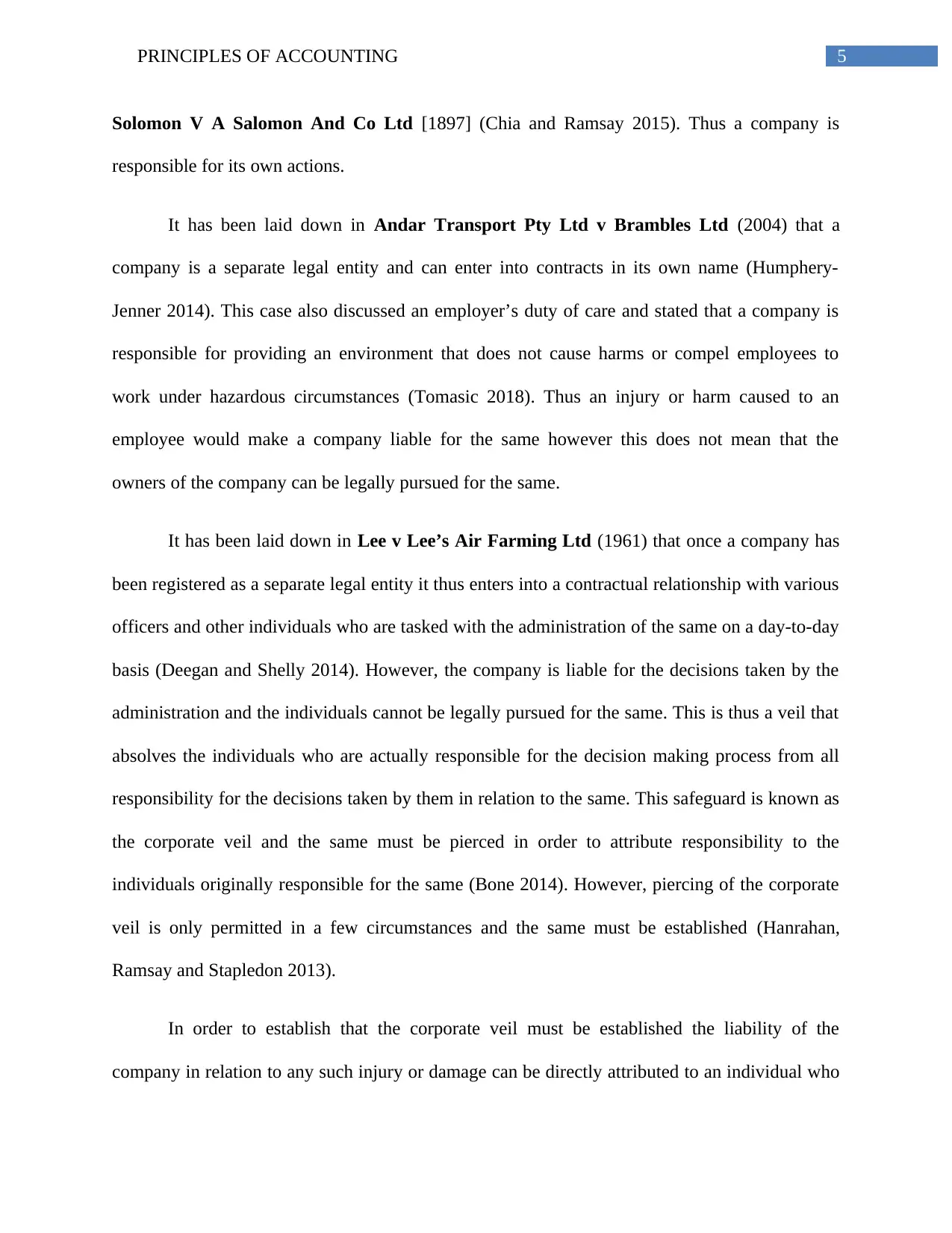
5PRINCIPLES OF ACCOUNTING
Solomon V A Salomon And Co Ltd [1897] (Chia and Ramsay 2015). Thus a company is
responsible for its own actions.
It has been laid down in Andar Transport Pty Ltd v Brambles Ltd (2004) that a
company is a separate legal entity and can enter into contracts in its own name (Humphery-
Jenner 2014). This case also discussed an employer’s duty of care and stated that a company is
responsible for providing an environment that does not cause harms or compel employees to
work under hazardous circumstances (Tomasic 2018). Thus an injury or harm caused to an
employee would make a company liable for the same however this does not mean that the
owners of the company can be legally pursued for the same.
It has been laid down in Lee v Lee’s Air Farming Ltd (1961) that once a company has
been registered as a separate legal entity it thus enters into a contractual relationship with various
officers and other individuals who are tasked with the administration of the same on a day-to-day
basis (Deegan and Shelly 2014). However, the company is liable for the decisions taken by the
administration and the individuals cannot be legally pursued for the same. This is thus a veil that
absolves the individuals who are actually responsible for the decision making process from all
responsibility for the decisions taken by them in relation to the same. This safeguard is known as
the corporate veil and the same must be pierced in order to attribute responsibility to the
individuals originally responsible for the same (Bone 2014). However, piercing of the corporate
veil is only permitted in a few circumstances and the same must be established (Hanrahan,
Ramsay and Stapledon 2013).
In order to establish that the corporate veil must be established the liability of the
company in relation to any such injury or damage can be directly attributed to an individual who
Solomon V A Salomon And Co Ltd [1897] (Chia and Ramsay 2015). Thus a company is
responsible for its own actions.
It has been laid down in Andar Transport Pty Ltd v Brambles Ltd (2004) that a
company is a separate legal entity and can enter into contracts in its own name (Humphery-
Jenner 2014). This case also discussed an employer’s duty of care and stated that a company is
responsible for providing an environment that does not cause harms or compel employees to
work under hazardous circumstances (Tomasic 2018). Thus an injury or harm caused to an
employee would make a company liable for the same however this does not mean that the
owners of the company can be legally pursued for the same.
It has been laid down in Lee v Lee’s Air Farming Ltd (1961) that once a company has
been registered as a separate legal entity it thus enters into a contractual relationship with various
officers and other individuals who are tasked with the administration of the same on a day-to-day
basis (Deegan and Shelly 2014). However, the company is liable for the decisions taken by the
administration and the individuals cannot be legally pursued for the same. This is thus a veil that
absolves the individuals who are actually responsible for the decision making process from all
responsibility for the decisions taken by them in relation to the same. This safeguard is known as
the corporate veil and the same must be pierced in order to attribute responsibility to the
individuals originally responsible for the same (Bone 2014). However, piercing of the corporate
veil is only permitted in a few circumstances and the same must be established (Hanrahan,
Ramsay and Stapledon 2013).
In order to establish that the corporate veil must be established the liability of the
company in relation to any such injury or damage can be directly attributed to an individual who
⊘ This is a preview!⊘
Do you want full access?
Subscribe today to unlock all pages.

Trusted by 1+ million students worldwide
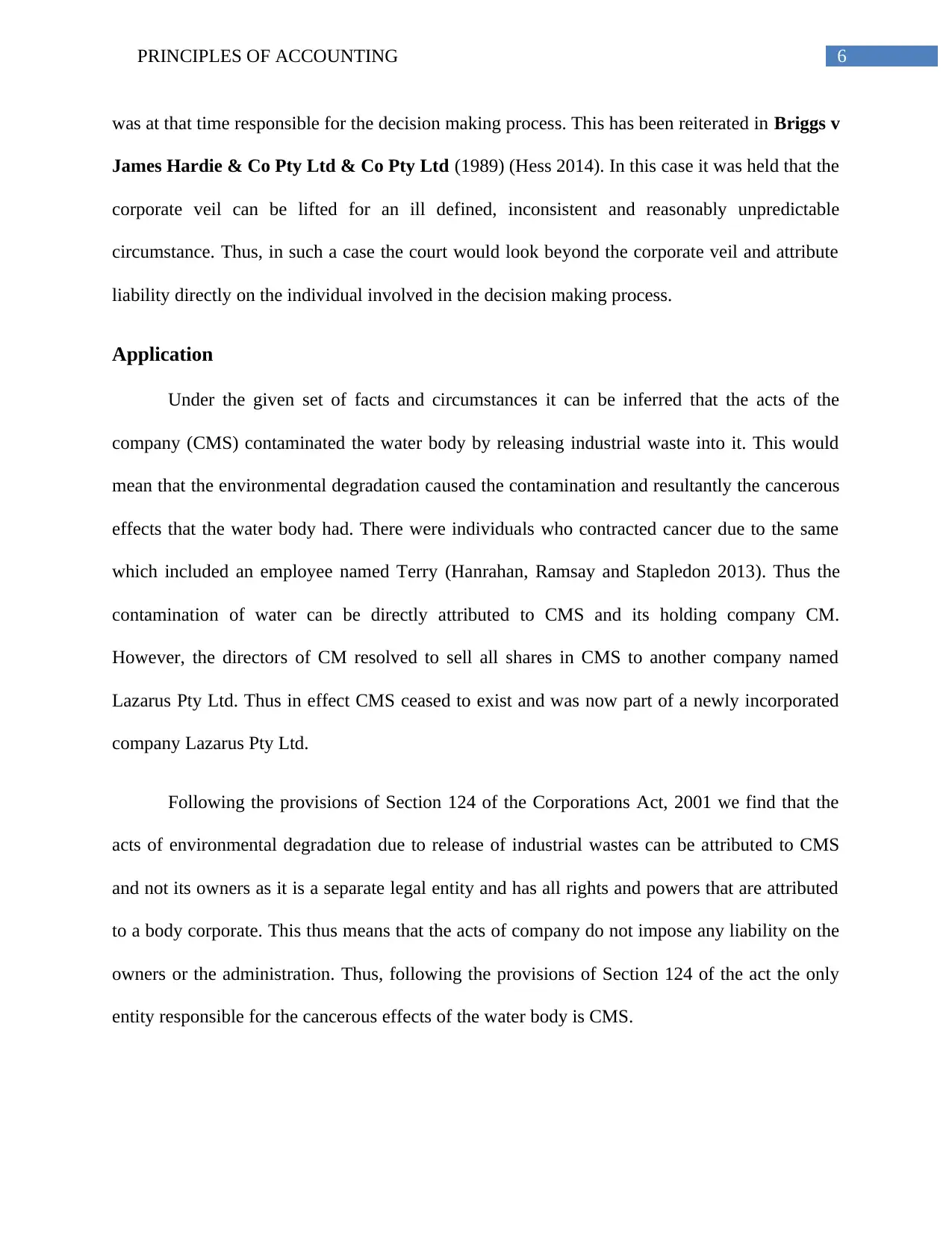
6PRINCIPLES OF ACCOUNTING
was at that time responsible for the decision making process. This has been reiterated in Briggs v
James Hardie & Co Pty Ltd & Co Pty Ltd (1989) (Hess 2014). In this case it was held that the
corporate veil can be lifted for an ill defined, inconsistent and reasonably unpredictable
circumstance. Thus, in such a case the court would look beyond the corporate veil and attribute
liability directly on the individual involved in the decision making process.
Application
Under the given set of facts and circumstances it can be inferred that the acts of the
company (CMS) contaminated the water body by releasing industrial waste into it. This would
mean that the environmental degradation caused the contamination and resultantly the cancerous
effects that the water body had. There were individuals who contracted cancer due to the same
which included an employee named Terry (Hanrahan, Ramsay and Stapledon 2013). Thus the
contamination of water can be directly attributed to CMS and its holding company CM.
However, the directors of CM resolved to sell all shares in CMS to another company named
Lazarus Pty Ltd. Thus in effect CMS ceased to exist and was now part of a newly incorporated
company Lazarus Pty Ltd.
Following the provisions of Section 124 of the Corporations Act, 2001 we find that the
acts of environmental degradation due to release of industrial wastes can be attributed to CMS
and not its owners as it is a separate legal entity and has all rights and powers that are attributed
to a body corporate. This thus means that the acts of company do not impose any liability on the
owners or the administration. Thus, following the provisions of Section 124 of the act the only
entity responsible for the cancerous effects of the water body is CMS.
was at that time responsible for the decision making process. This has been reiterated in Briggs v
James Hardie & Co Pty Ltd & Co Pty Ltd (1989) (Hess 2014). In this case it was held that the
corporate veil can be lifted for an ill defined, inconsistent and reasonably unpredictable
circumstance. Thus, in such a case the court would look beyond the corporate veil and attribute
liability directly on the individual involved in the decision making process.
Application
Under the given set of facts and circumstances it can be inferred that the acts of the
company (CMS) contaminated the water body by releasing industrial waste into it. This would
mean that the environmental degradation caused the contamination and resultantly the cancerous
effects that the water body had. There were individuals who contracted cancer due to the same
which included an employee named Terry (Hanrahan, Ramsay and Stapledon 2013). Thus the
contamination of water can be directly attributed to CMS and its holding company CM.
However, the directors of CM resolved to sell all shares in CMS to another company named
Lazarus Pty Ltd. Thus in effect CMS ceased to exist and was now part of a newly incorporated
company Lazarus Pty Ltd.
Following the provisions of Section 124 of the Corporations Act, 2001 we find that the
acts of environmental degradation due to release of industrial wastes can be attributed to CMS
and not its owners as it is a separate legal entity and has all rights and powers that are attributed
to a body corporate. This thus means that the acts of company do not impose any liability on the
owners or the administration. Thus, following the provisions of Section 124 of the act the only
entity responsible for the cancerous effects of the water body is CMS.
Paraphrase This Document
Need a fresh take? Get an instant paraphrase of this document with our AI Paraphraser
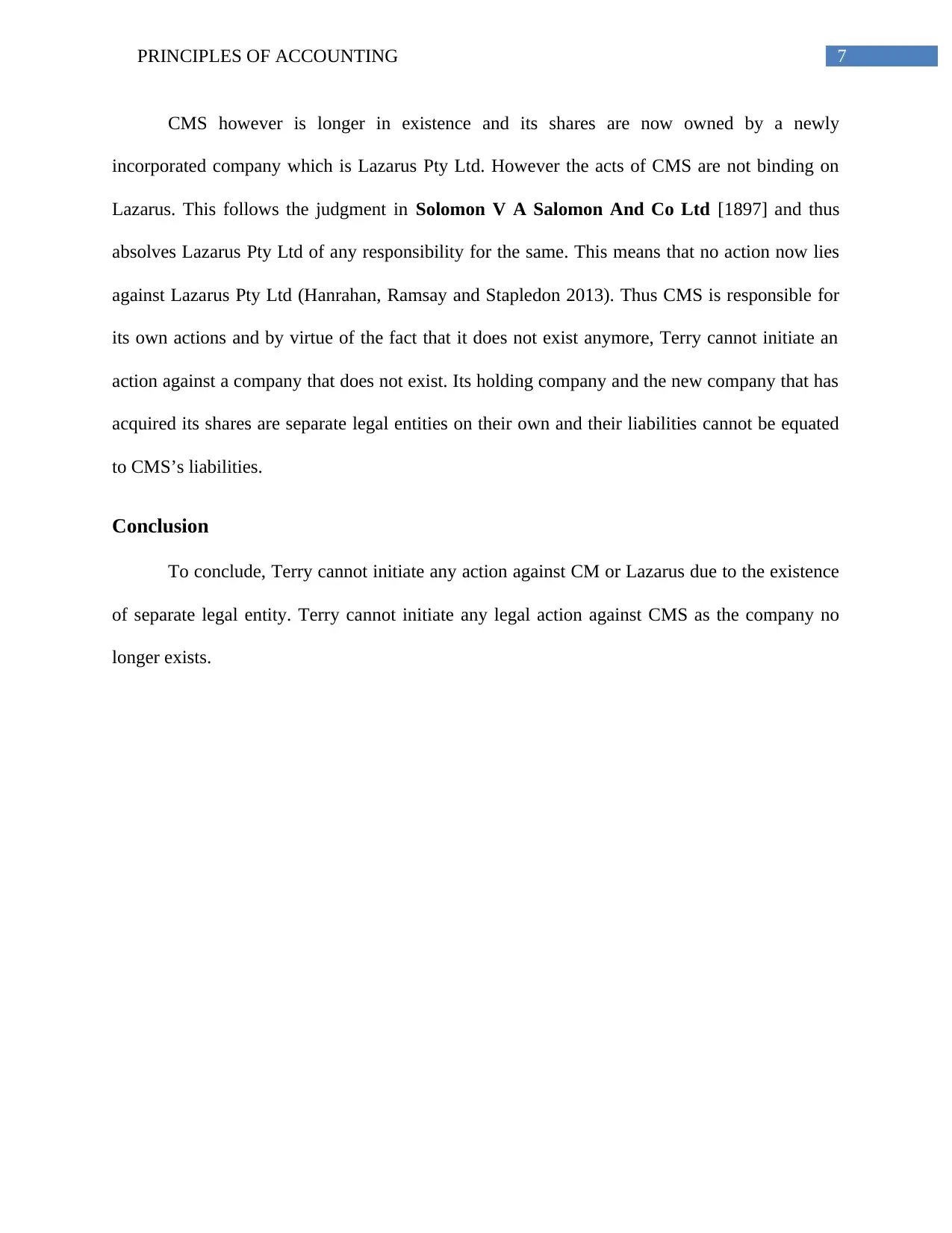
7PRINCIPLES OF ACCOUNTING
CMS however is longer in existence and its shares are now owned by a newly
incorporated company which is Lazarus Pty Ltd. However the acts of CMS are not binding on
Lazarus. This follows the judgment in Solomon V A Salomon And Co Ltd [1897] and thus
absolves Lazarus Pty Ltd of any responsibility for the same. This means that no action now lies
against Lazarus Pty Ltd (Hanrahan, Ramsay and Stapledon 2013). Thus CMS is responsible for
its own actions and by virtue of the fact that it does not exist anymore, Terry cannot initiate an
action against a company that does not exist. Its holding company and the new company that has
acquired its shares are separate legal entities on their own and their liabilities cannot be equated
to CMS’s liabilities.
Conclusion
To conclude, Terry cannot initiate any action against CM or Lazarus due to the existence
of separate legal entity. Terry cannot initiate any legal action against CMS as the company no
longer exists.
CMS however is longer in existence and its shares are now owned by a newly
incorporated company which is Lazarus Pty Ltd. However the acts of CMS are not binding on
Lazarus. This follows the judgment in Solomon V A Salomon And Co Ltd [1897] and thus
absolves Lazarus Pty Ltd of any responsibility for the same. This means that no action now lies
against Lazarus Pty Ltd (Hanrahan, Ramsay and Stapledon 2013). Thus CMS is responsible for
its own actions and by virtue of the fact that it does not exist anymore, Terry cannot initiate an
action against a company that does not exist. Its holding company and the new company that has
acquired its shares are separate legal entities on their own and their liabilities cannot be equated
to CMS’s liabilities.
Conclusion
To conclude, Terry cannot initiate any action against CM or Lazarus due to the existence
of separate legal entity. Terry cannot initiate any legal action against CMS as the company no
longer exists.
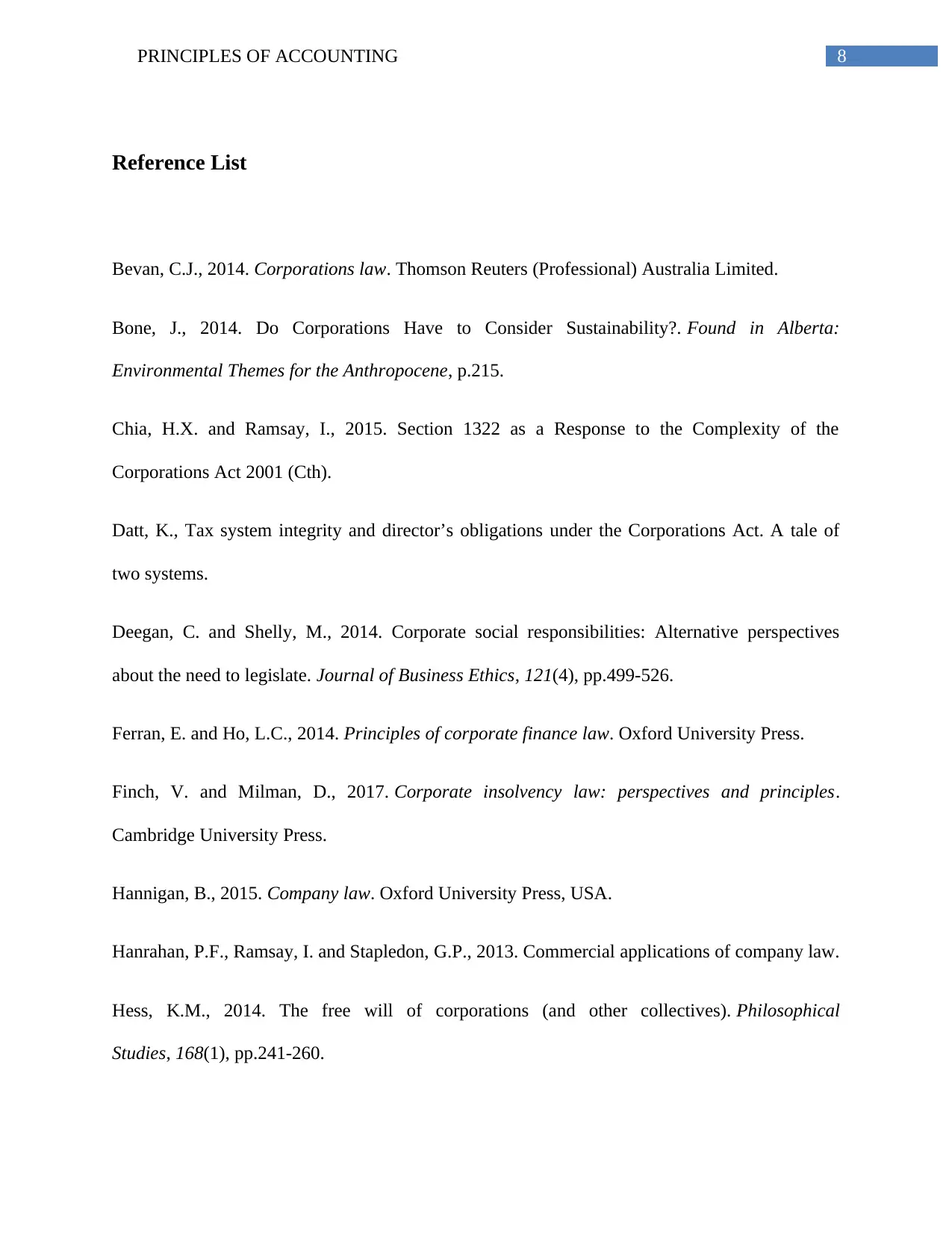
8PRINCIPLES OF ACCOUNTING
Reference List
Bevan, C.J., 2014. Corporations law. Thomson Reuters (Professional) Australia Limited.
Bone, J., 2014. Do Corporations Have to Consider Sustainability?. Found in Alberta:
Environmental Themes for the Anthropocene, p.215.
Chia, H.X. and Ramsay, I., 2015. Section 1322 as a Response to the Complexity of the
Corporations Act 2001 (Cth).
Datt, K., Tax system integrity and director’s obligations under the Corporations Act. A tale of
two systems.
Deegan, C. and Shelly, M., 2014. Corporate social responsibilities: Alternative perspectives
about the need to legislate. Journal of Business Ethics, 121(4), pp.499-526.
Ferran, E. and Ho, L.C., 2014. Principles of corporate finance law. Oxford University Press.
Finch, V. and Milman, D., 2017. Corporate insolvency law: perspectives and principles.
Cambridge University Press.
Hannigan, B., 2015. Company law. Oxford University Press, USA.
Hanrahan, P.F., Ramsay, I. and Stapledon, G.P., 2013. Commercial applications of company law.
Hess, K.M., 2014. The free will of corporations (and other collectives). Philosophical
Studies, 168(1), pp.241-260.
Reference List
Bevan, C.J., 2014. Corporations law. Thomson Reuters (Professional) Australia Limited.
Bone, J., 2014. Do Corporations Have to Consider Sustainability?. Found in Alberta:
Environmental Themes for the Anthropocene, p.215.
Chia, H.X. and Ramsay, I., 2015. Section 1322 as a Response to the Complexity of the
Corporations Act 2001 (Cth).
Datt, K., Tax system integrity and director’s obligations under the Corporations Act. A tale of
two systems.
Deegan, C. and Shelly, M., 2014. Corporate social responsibilities: Alternative perspectives
about the need to legislate. Journal of Business Ethics, 121(4), pp.499-526.
Ferran, E. and Ho, L.C., 2014. Principles of corporate finance law. Oxford University Press.
Finch, V. and Milman, D., 2017. Corporate insolvency law: perspectives and principles.
Cambridge University Press.
Hannigan, B., 2015. Company law. Oxford University Press, USA.
Hanrahan, P.F., Ramsay, I. and Stapledon, G.P., 2013. Commercial applications of company law.
Hess, K.M., 2014. The free will of corporations (and other collectives). Philosophical
Studies, 168(1), pp.241-260.
⊘ This is a preview!⊘
Do you want full access?
Subscribe today to unlock all pages.

Trusted by 1+ million students worldwide
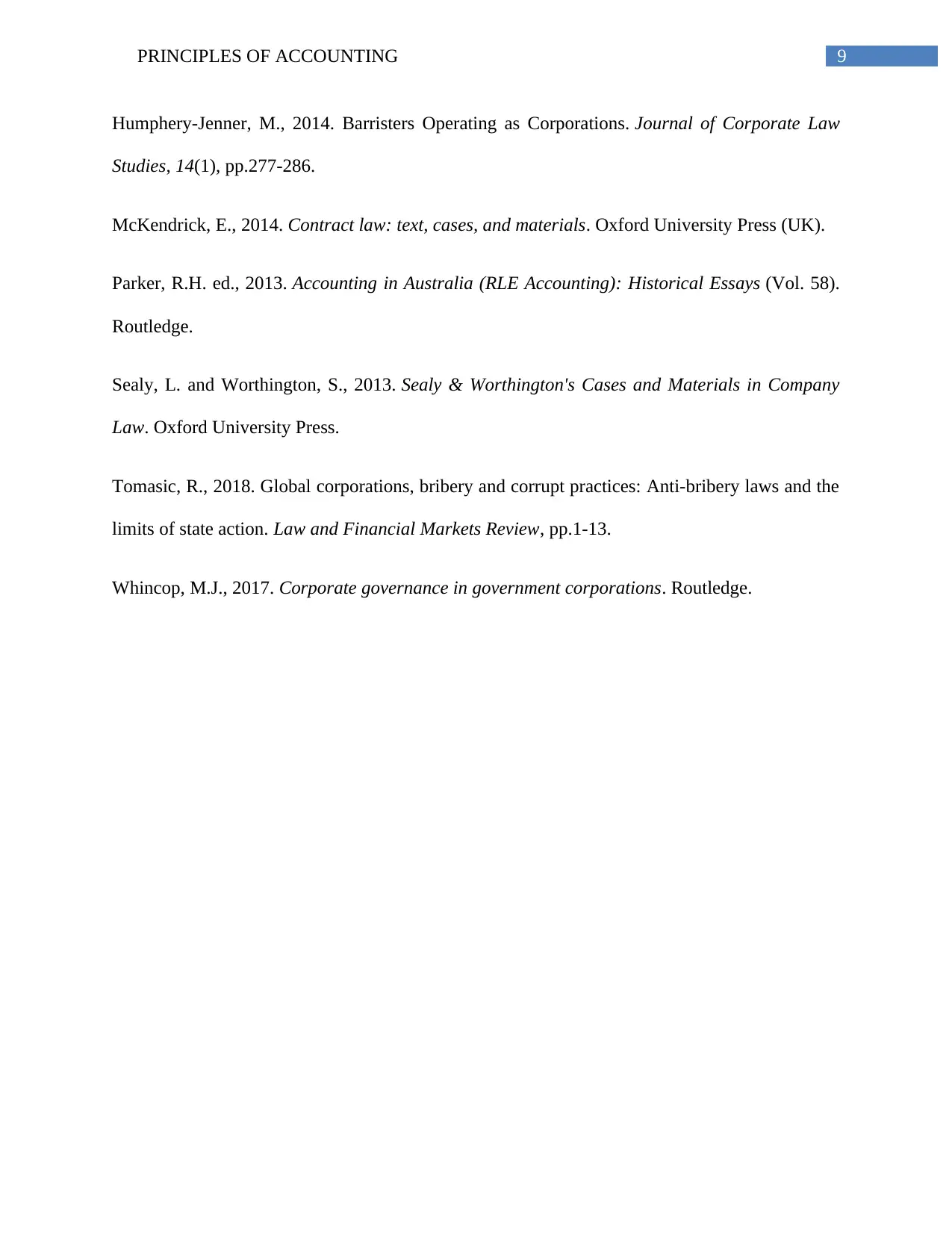
9PRINCIPLES OF ACCOUNTING
Humphery-Jenner, M., 2014. Barristers Operating as Corporations. Journal of Corporate Law
Studies, 14(1), pp.277-286.
McKendrick, E., 2014. Contract law: text, cases, and materials. Oxford University Press (UK).
Parker, R.H. ed., 2013. Accounting in Australia (RLE Accounting): Historical Essays (Vol. 58).
Routledge.
Sealy, L. and Worthington, S., 2013. Sealy & Worthington's Cases and Materials in Company
Law. Oxford University Press.
Tomasic, R., 2018. Global corporations, bribery and corrupt practices: Anti-bribery laws and the
limits of state action. Law and Financial Markets Review, pp.1-13.
Whincop, M.J., 2017. Corporate governance in government corporations. Routledge.
Humphery-Jenner, M., 2014. Barristers Operating as Corporations. Journal of Corporate Law
Studies, 14(1), pp.277-286.
McKendrick, E., 2014. Contract law: text, cases, and materials. Oxford University Press (UK).
Parker, R.H. ed., 2013. Accounting in Australia (RLE Accounting): Historical Essays (Vol. 58).
Routledge.
Sealy, L. and Worthington, S., 2013. Sealy & Worthington's Cases and Materials in Company
Law. Oxford University Press.
Tomasic, R., 2018. Global corporations, bribery and corrupt practices: Anti-bribery laws and the
limits of state action. Law and Financial Markets Review, pp.1-13.
Whincop, M.J., 2017. Corporate governance in government corporations. Routledge.
1 out of 10
Related Documents
Your All-in-One AI-Powered Toolkit for Academic Success.
+13062052269
info@desklib.com
Available 24*7 on WhatsApp / Email
![[object Object]](/_next/static/media/star-bottom.7253800d.svg)
Unlock your academic potential
Copyright © 2020–2025 A2Z Services. All Rights Reserved. Developed and managed by ZUCOL.




